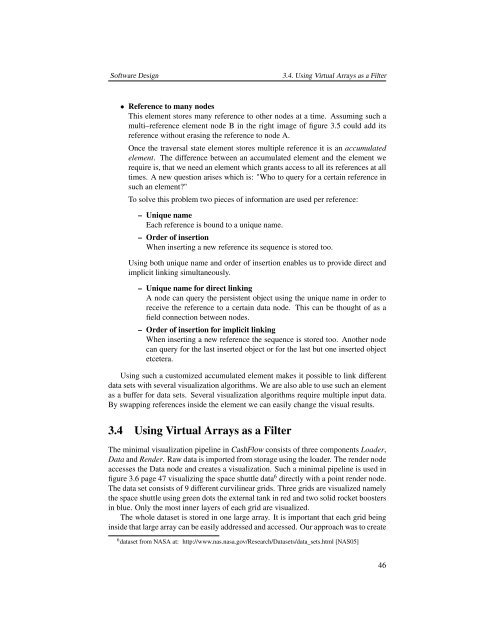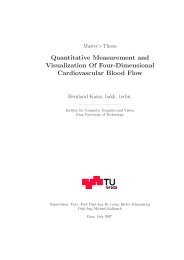CashFlow, A Visualization Framework for 3D Flow - Studierstube ...
CashFlow, A Visualization Framework for 3D Flow - Studierstube ...
CashFlow, A Visualization Framework for 3D Flow - Studierstube ...
- No tags were found...
Create successful ePaper yourself
Turn your PDF publications into a flip-book with our unique Google optimized e-Paper software.
Software Design3.4. Using Virtual Arrays as a Filter• Reference to many nodesThis element stores many reference to other nodes at a time. Assuming such amulti–reference element node B in the right image of figure 3.5 could add itsreference without erasing the reference to node A.Once the traversal state element stores multiple reference it is an accumulatedelement. The difference between an accumulated element and the element werequire is, that we need an element which grants access to all its references at alltimes. A new question arises which is: "Who to query <strong>for</strong> a certain reference insuch an element?"To solve this problem two pieces of in<strong>for</strong>mation are used per reference:– Unique nameEach reference is bound to a unique name.– Order of insertionWhen inserting a new reference its sequence is stored too.Using both unique name and order of insertion enables us to provide direct andimplicit linking simultaneously.– Unique name <strong>for</strong> direct linkingA node can query the persistent object using the unique name in order toreceive the reference to a certain data node. This can be thought of as afield connection between nodes.– Order of insertion <strong>for</strong> implicit linkingWhen inserting a new reference the sequence is stored too. Another nodecan query <strong>for</strong> the last inserted object or <strong>for</strong> the last but one inserted objectetcetera.Using such a customized accumulated element makes it possible to link differentdata sets with several visualization algorithms. We are also able to use such an elementas a buffer <strong>for</strong> data sets. Several visualization algorithms require multiple input data.By swapping references inside the element we can easily change the visual results.3.4 Using Virtual Arrays as a FilterThe minimal visualization pipeline in <strong>Cash<strong>Flow</strong></strong> consists of three components Loader,Data and Render. Raw data is imported from storage using the loader. The render nodeaccesses the Data node and creates a visualization. Such a minimal pipeline is used infigure 3.6 page 47 visualizing the space shuttle data 6 directly with a point render node.The data set consists of 9 different curvilinear grids. Three grids are visualized namelythe space shuttle using green dots the external tank in red and two solid rocket boostersin blue. Only the most inner layers of each grid are visualized.The whole dataset is stored in one large array. It is important that each grid beinginside that large array can be easily addressed and accessed. Our approach was to create6 dataset from NASA at: http://www.nas.nasa.gov/Research/Datasets/data_sets.html [NAS05]46





